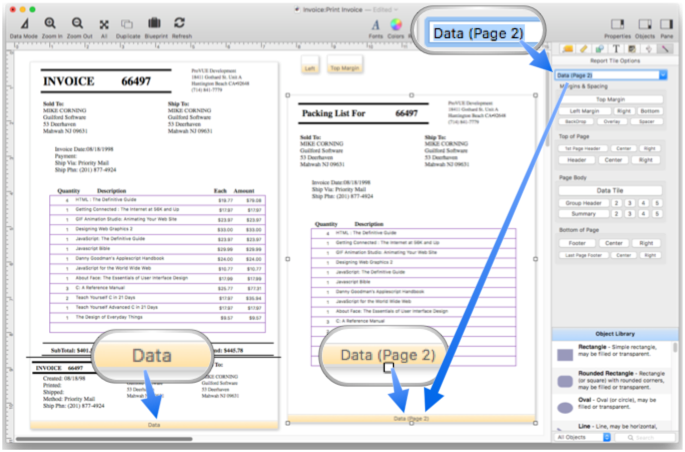If the data tile is made large enough to fill the entire page, Panorama will print only one record per page. In some cases, a single page is not enough. For example, you may need to print an invoice, statement or tax return with several pages per record. Panorama can print up to 25 pages for each record.
To print a multiple page form you will need to create multiple data tiles. The tiles for additional pages can be identified by the page number in the drag bar of the tile. When you create a data tile for an additional page it should be large enough to fill the entire sheet of paper, just like the first data tile. When a form contains multiple data tiles to print multiple pages for a single record, Panorama will ignore any header or footer tiles. Only the margins and data tiles will be printed. This example shows a form for simultaneously printing an invoice and packing slip.

When you print this form, both pages will print automatically for each record printed. If you use File>Print One Record Panorama will automatically print the current invoice and packing slip. If you use the regular Print command, Panorama will print an invoice and packing slip for each selected record.

Selectively Printing Multiple Pages per Record
Panorama allows up to 25 pages to be printed per record using data tiles 1 through 25. However, you do not have to print all tiles for each record, you can print them selectively using a formula on the form. For example, you can easily ask Panorama to print pages 1, 2, and 5 for one record and 1 and 4 for another record (page one, the primary data tile, always prints). You could use this feature to selectively print an envelope, to print only selected portions of a tax return, to print one or two page invoices, etc.
To control which extra data tiles get printed, you must use the extrapages( function. This function must be put in a formula in a Text Display Object somewhere on the main data tile. This function has one parameter, a Text Array with a list of the extra pages to be printed. This list may be delimited by commas, spaces, tabs, carriage returns or line feeds. For example if you want to print pages 1, 2, and 5 you would need to use a formula like this:
extrapages("2,5")
Usually you would use a field or variable to selectively control which pages print instead of a fixed string. To illustrate this let’s modify the invoice example from the previous section. This form would always print both an invoice and a packing slip. By adding an extrapages( function we can modify the form so that a packing slip is not printed if the shipping method is Will Call.

The extrapages( function may be placed anywhere on the primary Data tile. The function has no result, so it won’t cause anything to be printed. In this case if the shipping method is Priority Mail, FedEx, UPS, or anything except Will Call, the ?( function will produce "2" and the second page (the packing list) will print. If the shipping method is Will Call the ?( function will produce "" and the packing list will not print.
Using an Extra Page List without Delimiters (Legacy Compatibility)
Before Panorama X 10.2, only 9 pages could be printed per record. In those earlier versions, the list of page numbers could be specified without a delimiter. For example, instead of:
extrapages("2,5")
You could use the formula:
extrapages("25")
Both of these formulas specify that pages 1, 2, and 5 should be printed.
For compatibility, this “no delimiters” format still works, but if delimiters are not used then only single digit page numbers can be specified (2 thru 9). If you want to use page 10 or higher you must include delimiters in the text array.
See Also
- Automatic Mailing Label Construction -- creates a mailing label.
- Automatic Report Construction -- creates a tabular report with columns of data.
- Custom Report Headers and Footers -- setting up custom report headers and footers.
- Custom Report Margins -- specifying the top, left, right and bottom margins of a custom report.
- Printing Multiple Column Reports -- printing reports with two, three or more columns (for example mailing labels).
- Printing Summary Information -- printing a database that has been organized into categories with summary records.
- Report Tile Object -- component for assembling a custom report.
- Reports -- Panorama has a very flexible system for printing custom reports, labels and forms.
- setreportcolumns -- allows a procedure to control the number of columns of a report, and the direction (across or down).
- Tiles In Action -- basic rules for using tiles to print custom reports.
- Variable Height Records -- custom reports with different heights for each record.
- View-As-List Forms -- displaying a custom data layout as a continuous sheet.
History
| Version | Status | Notes |
| 10.2 | Updated | Now allows separator characters delimiting the page numbers in the extrapages( list, allowing the use of double digit page numbers (up to 25 pages per record). |
| 10.0 | Updated | Carried over from Panorama 6.0, with some updates. |